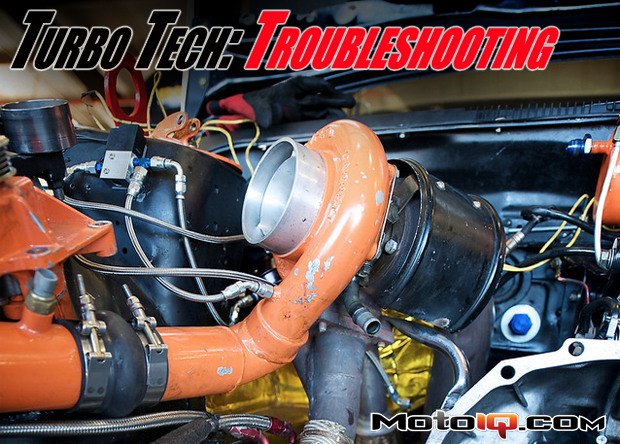
Turbo Tech: Turbo Troubleshooting
FACT: most of the time, the turbo is not the source of the problem. One caveat to this statement, this only applies to turbos made by one of the major OEM turbo manufacturers (they are really the only ones capable of properly engineering turbos): Honeywell Turbo/Garrett, Borg Warner, MHI, IHI, and Cummins. Out of all of the turbos that get swapped by dealers and shops (think diesel big rigs, work trucks, construction equipment, etc), an average of 90% of them have absolutely nothing wrong with them. Of the remaining 10%, about 5% or so of the failures were due to user error. Basically, the dealers see a performance issue and jump to the conclusion of a faulty turbo, and they would be wrong. Also, let me say this up front, turbos don’t have seals! I’ll explain this more in-depth in a bit.
Remember that turbos are pretty simple devices with the main components on a basic turbo being: compressor wheel, turbine wheel, a shaft that connects the two, and the bearing system. They get a little more complicated with the addition of variable nozzle turbine parts, but still pretty basic stuff overall. Exhaust goes in to turn the turbine wheel and flows out. The turbine spins the compressor which sucks air in and pushes it out. Oil goes in to support and cool the bearings and flows out. Water goes in for cooling and flows out. As they say, the devil is in the details which separates the well-engineered turbos from the bad turbos (and probably not engineered at all), but if a turbo checks out fine on the end-of-line quality check, it’s probably fine.
 Here’s part of a guide you can find at TurbobyGarrett to help troubleshoot issues on turbocharged vehicles.
Here’s part of a guide you can find at TurbobyGarrett to help troubleshoot issues on turbocharged vehicles.The Aftermarket world is a bit different from the OEM world though, in that you have a bunch of hacks that supposedly know what they’re doing working on customer cars. There are many many (many) sources of performance problems as you can see in the Garrett Troubleshooting Guide, but let me go over a couple real world examples I’ve dealt with.
A so-called tuner somehow got a hold of my work number and was completely flipping out. He had swapped out the stock turbo on a vehicle for a bigger one and wasn’t seeing any performance gains. So of course, he assumed something was wrong with the turbo. The situation was that he was running more boost than he was on the stock turbo, yet only making the same power and even less. So I asked about some basic things like checking for boost leaks, etc. He said everything checked out. After not really getting anywhere with him, I asked for datalogs. So I go through the datalogs and compare MAF readings. The bigger turbo was flowing 30%-40% more than the stock turbo which was clearly in the datalogs. I dug a little deeper and checked the timing and found that the values were extremely low. This was super simple data analysis and troubleshooting that the tuner should have done instead of freaking out. Higher MAF readings equaled proof the bigger turbo was indeed flowing more air. Low ignition timing explained the low power. So I made some pretty little charts in Excel to show the issues and emailed the info to him. I never did hear back from the guy. Funny thing though, a few days later on a forum, a customer talks about how good of a job the tuner did on their car…
Probably the most common issue we hear about in the Aftermarket world is oil smoke. This is where we get into the issues of ‘seals’. Turbos don’t have a seal in the way you might commonly think of seals; it’s not like Tupperware where you close the lid and you get an air-tight seal. Turbos use a combination of piston rings and other tricks to try to keep oil in the center housing and out of the compressor and turbine housings. Piston rings in turbos are a type of dynamic seal which sits between the rotating shaft and the stationary center housing. They help prevent oil from leaking past but they are not a 100% seal, so oil does get by them. The cause of oil leaking past the piston rings is pressure.
 The piston rings, or ‘seals’ don’t really go bad. There is the very slight chance they can be damaged during installation, but that’s very uncommon. If you think the ‘seals’ are bad, then you most likely have a much bigger problem which is bearing system failure. If the bearing system is on the way out, it allows the shaft to wobble a lot, leading to piston ring damage and wheel rubs. Turbos employ a couple other techniques to create oil slingers. The goal of the oil slinger is to fling/sling the oil away from the ends of the shaft. In the case of the turbo in the picture, two grooves are machined that act as the slingers. The reduced volume of oil at the ends means less oil can leak out.
The piston rings, or ‘seals’ don’t really go bad. There is the very slight chance they can be damaged during installation, but that’s very uncommon. If you think the ‘seals’ are bad, then you most likely have a much bigger problem which is bearing system failure. If the bearing system is on the way out, it allows the shaft to wobble a lot, leading to piston ring damage and wheel rubs. Turbos employ a couple other techniques to create oil slingers. The goal of the oil slinger is to fling/sling the oil away from the ends of the shaft. In the case of the turbo in the picture, two grooves are machined that act as the slingers. The reduced volume of oil at the ends means less oil can leak out.There are basically three areas of pressure in a turbo: compressor side, turbine side, and within the center housing. If the pressures in the compressor and turbine housings are greater than the center housing, then oil will not leak out. If the pressure in the center housing is greater than the compressor and turbine housings, then oil may leak past the piston rings.




2 comments
If I use a scavenger pump can I run more of an angle of tilt ?
I suppose it would reduce or prevent oil from leaking out the one side of the turbo. If you angle too much, it’ll also starve oil from the part of the bearing that’s high.